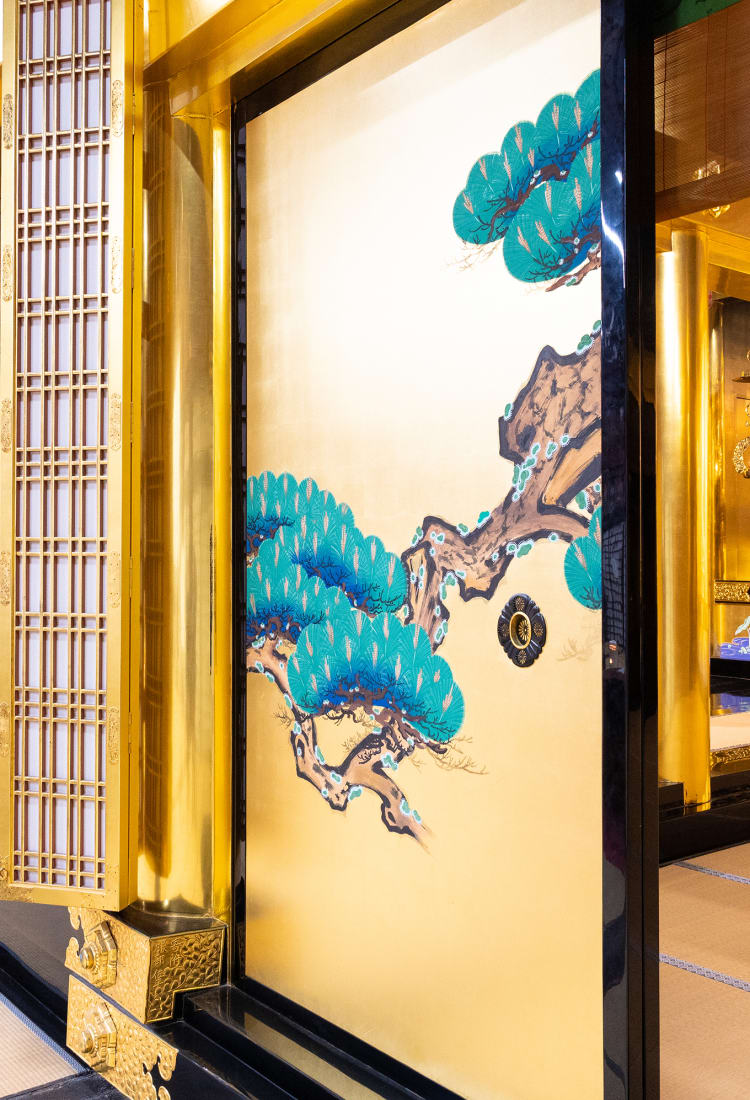
2021.03 Kanazawa Gold Leaf: An Art Passed Down Through Generations
The ancient technique of creating gold leaf lives on in Kanazawa
Kanazawa’s golden heritage
Kanazawa City is located on the Sea of Japan coast in central Honshu, Japan’s main island. It is the largest city in the Hokuriku region, about three hours from Tokyo on the Hokuriku Shinkansen. Kanazawa is a popular sightseeing area with many cultural attractions, such as Kenrokuen garden, the 21st Century Museum of Contemporary Art and the traditional Higashi Chaya geisha district, lined with teahouses from the Edo period (1603–1867).
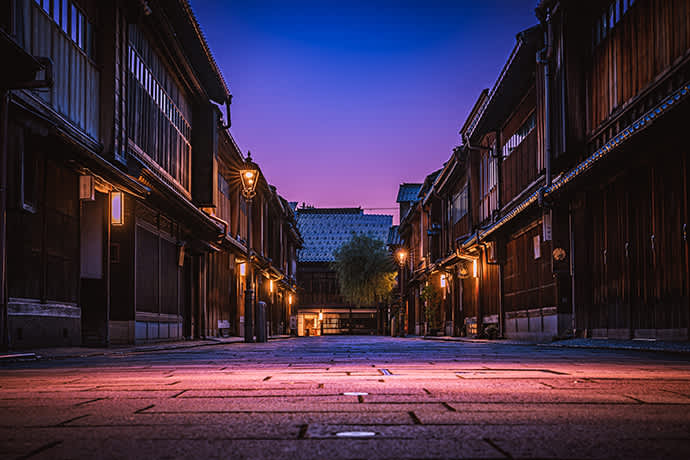
The Higashi Chaya District is a traditional geisha district that embodies Kanazawa Culture.
Kanazawa has thrived as a center of gold leaf production since the sixteenth century. Gold leaf made using the entsuke technique is unique to Kanazawa and is used to decorate national treasures and cultural properties, including the Konjikido Golden Hall of Chusonji Temple (Iwate Prefecture), Nishi-Honganji Temple (Kyoto Prefecture) and Hongwanji Kanazawa Betsuin (Ishikawa Prefecture). In 2014, Japan certified entsuke gold leaf as a Selected Conservation Technique, and in December 2020, UNESCO added entsuke gold leaf to its list of Intangible Cultural Heritage.

“It is said that Kanazawa gold leaf originated from Kyoto and was introduced here in 1593,” says Kenichi Matsumura, who has been a gold leaf craftsman for 42 years. He is also the president of the Society for the Preservation of Kanazawa Gold Leaf Traditional Techniques, which was established to protect and pass on those skills. Kenichi was born in Kanazawa City and, from age 18, apprenticed with his father to become an entsuke gold leaf artisan. In 2001, he was certified as a traditional craftsperson of Kanazawa gold leaf and, since then, has been working to ensure the technique’s succession.
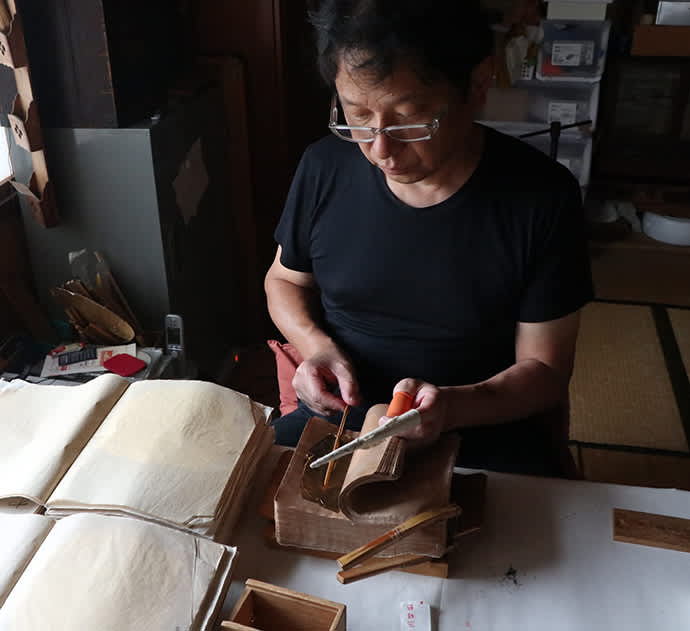
Three generations of Kenichi Matsumura’s family have been involved in making gold leaf.
Two kinds of gold leaf are made in Kanazawa — entsuke and tachikiri. Entsuke gold leaf involves a traditional manufacturing method that uses handmade Japanese washi paper. Extremely thin and supple, with exquisite color and luster, entsuke gold leaf is essential for the preservation of Japan’s important cultural properties. This technique, which requires the highest level of skill, has existed for more than 400 years and is now being passed on by just a handful of artisans. Tachikiri gold leaf was developed in the 1960s, using modern manufacturing methods to enable the mass production of gold leaf.
Admire historic buildings with opulent entsuke gold leaf gilding
The splendor of entsuke gold leaf’s magnificent color and luster is best expressed by Hongwanji Kanazawa Betsuin, which is only about a three-minute drive from Kanazawa Station. It belongs to the Jodo Shinshu, or Pure Land Buddhism school, the most common type of Buddhism in Japan.
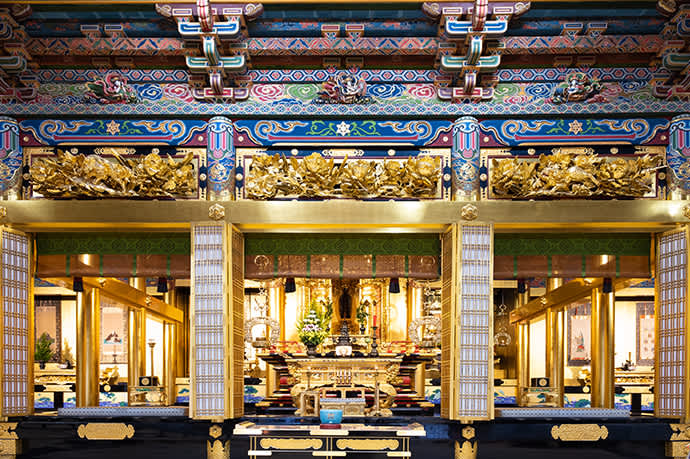
The inner temple of Hongwanji Kanazawa Betsuin was restored in 1993 using entsuke gold leaf. Photo credit: Hongwanji Kanazawa Betsuin
At Buddhist temples, the most revered objects of worship are often enshrined in the inner sanctum of the main temple building. At Hongwanji Kanazawa Betsuin, a statue of Amida Nyorai (Amitabha Tathagata or Buddha of Infinite Light), and the pillars and doors of this inner sanctum, are all dazzlingly gilded with entsuke gold leaf.
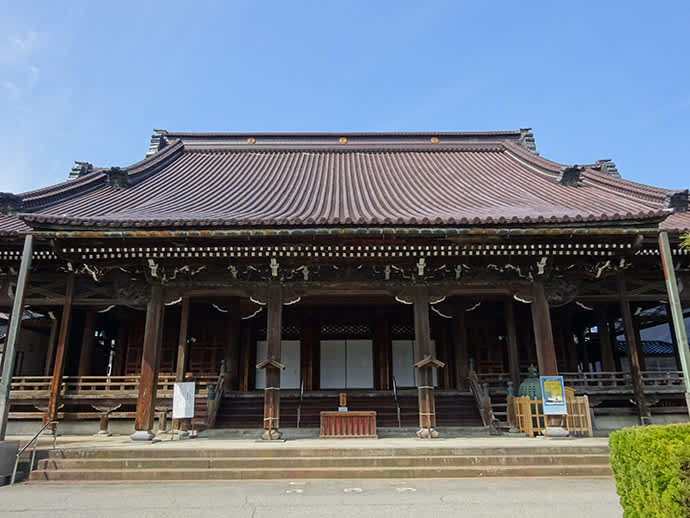
The main temple building was completed in 1849. Photo credit: Hongwanji Kanazawa Betsuin
At temples that belong to the Jodo Shinshu school, the main temple building is constructed with an inner sanctum, which represents the Pure Land, a kind of utopia. Entsuke gold leaf is not simply a decoration in such temples; it is used to depict the shining world of the Pure Land and the salvation of Amida Nyorai.
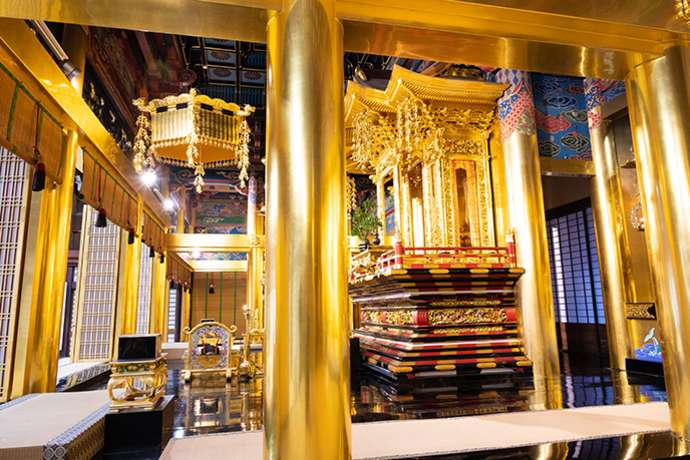
Hongwanji Kanazawa Betsuin is a designated tangible cultural property of Kanazawa Prefecture. Photo credit: Hongwanji Kanazawa Betsuin
Just a few minutes’ walk from the Higashi Chaya District in downtown Kanazawa, the Kanazawa Yasue Gold Leaf Museum is Japan’s only museum exclusively about gold leaf production and gilding. Visitors can learn the history of gold leaf through art works and crafted items that feature gilding, including fabrics, pottery, sculptures and works of calligraphy. The museum also displays historical implements used to make gold leaf.

Old implements used to make gold leaf are on permanent display (left). A precious, 160-year-old brocade robe that uses gold leaf (right). Both photo credit: Kanazawa Yasue Gold Leaf Museum
The artisanal technique of creating featherweight gold
Entsuke gold leaf is defined by strict production conditions. Currently, there are just over 10 artisans in Kanazawa who are capable of manufacturing it. The process is divided into three stages that apply years of expert skill.
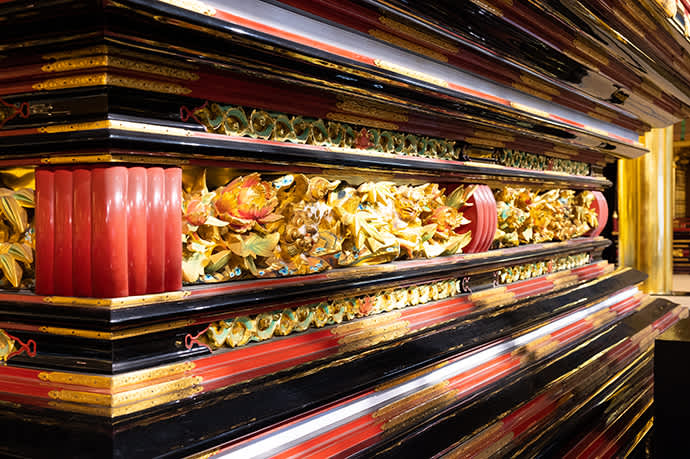
Entsuke gold leaf is an essential decorative material in various fields, including temple decoration. Photo credit: Hongwanji Kanazawa Betsuin
Zumi: Making an alloy and processing the gold
First, pure gold is mixed together with a tiny amount of silver and copper and melted at a temperature of around 1,300 degrees Celsius (2,370 degrees Fahrenheit) to create an alloy. The alloy is stretched between metal rollers, cut into five-centimeter squares, then sandwiched between layers of paper and pounded by machine to a thickness of 1/1,000 of a millimeter (1 micron). This process (zumi) is used to make both entsuke and tachikiri gold leaf and is carried out by a specialized artisan called a zumiya.
Hakuuchi: Hammering the gold
The gold leaf is then layered alternately with hakuuchi paper, which is a special handmade Japanese washi paper (traditional paper made from bark or natural fibers), and hammered in a hand-operated machine to stretch it even more. The gold leaf is then transferred to new layers of hakuuchi paper. After being warmed by electric heating equipment, this hammering process is repeated until the gold reaches an ultimate thickness of 1/10,000 of a millimeter (0.1 microns).
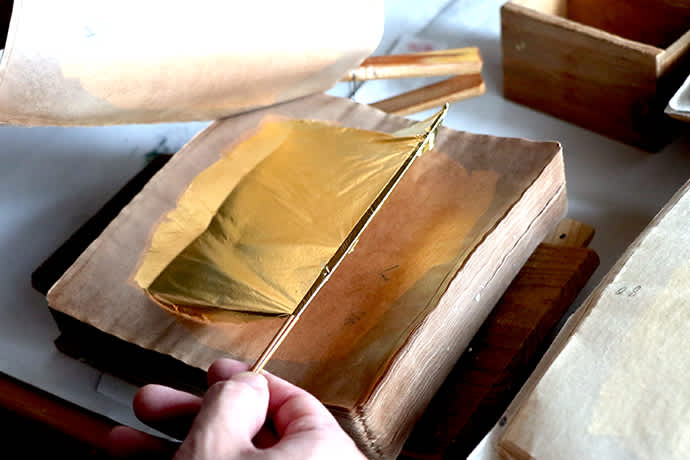
Gold leaf that has been hammered to a thickness of just 1/10,000 of a millimeter (0.1 microns). Photo credit: Gold Leaf Sakuda
The resulting sheets are cut one by one to a specified size, using a dedicated cutting tool made of bamboo. On average, it takes two weeks for 100 sheets to be made in this entsuke way. The artisans who hammer the gold are called hakuuchi-shi.
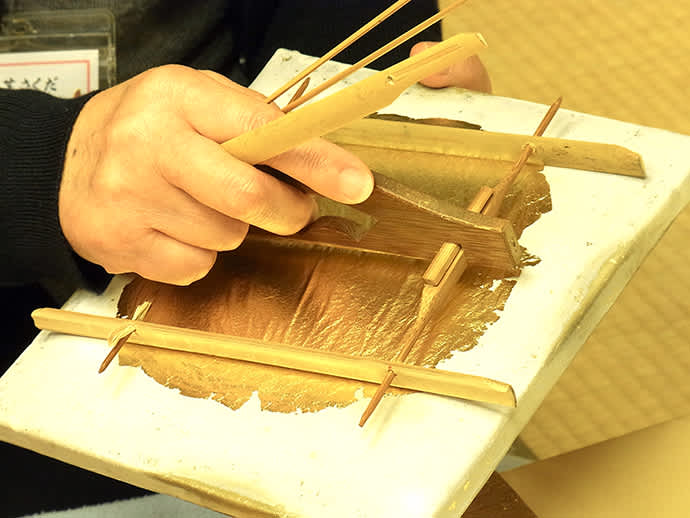
Each sheet of cut gold leaf is carefully layered alternately with paper. A set of gold leaf comprises 100 sheets. Photo credit: Gold Leaf Sakuda
Kamishikomi: Making the paper for use in the hammering process
To make entsuke gold leaf the alloy must be hammered as thinly as possible with skill and precision so as not to damage the gold leaf in any way. The key is the protective paper placed beneath and on top of each sheet of gold leaf during the hammering process, known as hakuuchi-gami.
“The zumiya and the hakuuchi-shi each make the paper themselves, because precision is paramount, and the quality of the paper greatly affects the finish of the final product,” says Kenichi Matsumura. The process of making the paper is called kamishikomi.
The paper is handmade from pulp using fine clay and the fibers of a plant called ganpi (Diplomorpha sikokiana), and then processed. The kamishikomi processing begins by cutting the paper into squares and removing any particles of dust and impurities. The paper squares are then stacked and left to moisten overnight, sat in a small amount of water. The next day, the paper is beaten to ensure the squares are evenly moist, and the individual sheets are slowly peeled from the stack one at a time. This process is repeated around 20 times until all the sheets have been peeled from one another.

The work of peeling the paper is called tekazu. Photo credit: Gold Leaf Sakuda
The sheets of paper are then bundled again, and soaked in a mixture of lye, persimmon juice, egg yolk and egg white. Ash from burned straw is mixed with water to make the akujiru or lye (caustic soda), which helps to create strong, smooth paper and neutralize the paper’s acid content. After the bundles have absorbed enough of the mixture, they are wrung out and then sandwiched between woven rush matting to further remove any excess liquid. The sheets are then peeled apart, and beaten again to ensure an even moistness. Finally, the sheets are dried one-by-one over a flame, then beaten again. This painstaking process ensures all the moisture is removed, so that the gold leaf does not stick to the paper.

Paper soaking in the lye (akujiru) (left). The sheets of paper are beaten repeatedly using a special machine (right). Both photo credit: Gold Leaf Sakuda
“The process of kamishikomi alone takes between six months and one year. More than anything, experience and intuition are key. If the hakuuchi paper is not made well, the gold leaf will stick to the paper, and no matter how much you hammer it, the gold leaf won’t stretch thinly and evenly. About 90% of the technical skill required to make entsuke gold leaf is concentrated in the kamishikomi process,” says Kenichi Matsumura.
It takes three years just to learn the basics of entsuke gold leaf production from the kamishikomi to hakuuchi processes. These skills are mostly passed on from parent to child. Kanazawa’s gold leaf industry continues to sustain the beauty of Japan’s national treasures and historic buildings.
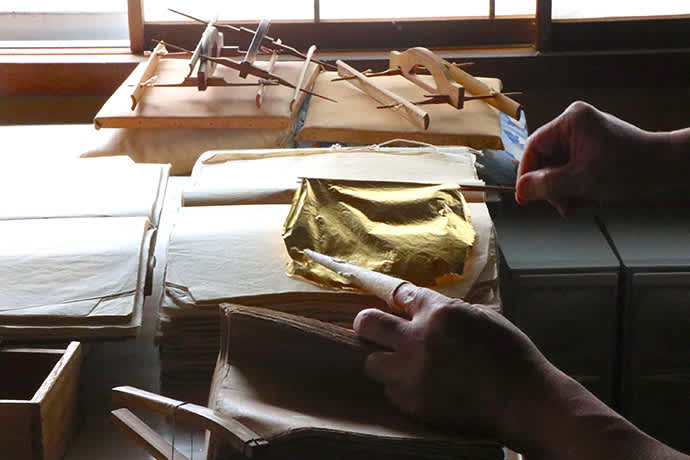
Kenichi Matsumura says, “We have to think about how the next generation can inherit this process, including the conservation of raw materials.” Photo credit: Gold Leaf Sakuda
Working with gold that’s lighter than air
Gilding with Kanazawa gold leaf is also the job of an artisan. The gold leaf is so thin and delicate that it can be torn with a single touch. The gold leaf is handled with bamboo chopsticks to prevent the buildup of static electricity. Expert skill is required to join the edges of each gold leaf sheet as it is applied to sophisticated shapes, all while maintaining a steady working speed.
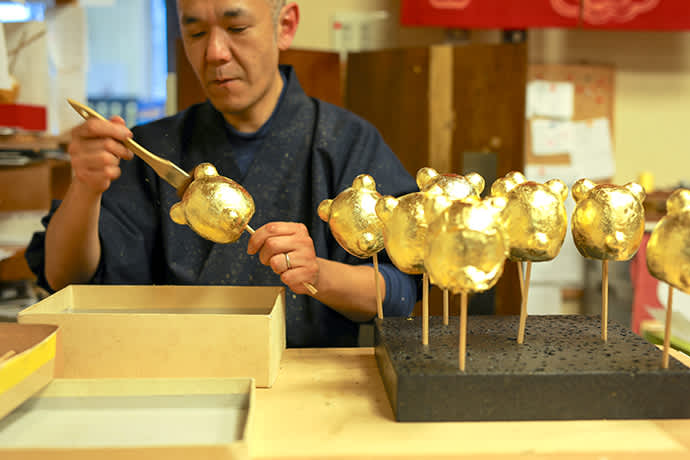
To prevent wasting gold leaf, it is applied without overlap. Photo credit: Gold Leaf Sakuda
For those who would like to try gilding with Kanazawa gold leaf, Gold Leaf Sakuda, near the picturesque Higashi Chaya District, offers a gold leaf workshop. The company was established in 1919 by an artisan of gold leaf production and, as well as selling a wide variety of original gold leaf handicrafts, they offer gilding workshops for visitors. The workshops take place four times a day, with each session lasting about 60 minutes. The workshops are available in English and Chinese.
Gold Leaf Gilding Workshop
Participants first select and purchase a product they would like to gild. Options include chopsticks, saucers, small mirrors, blossom-shaped boxes, and many other products.
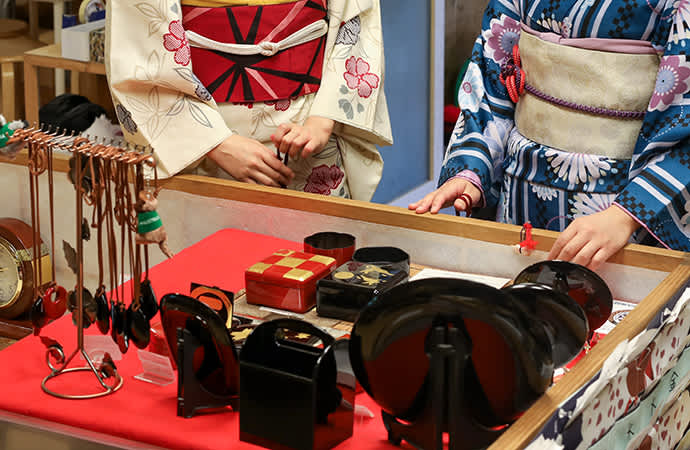
You can choose from products ranging from small saucers to large plates for interior decoration. Photo credit: Gold Leaf Sakuda
Participants then draw a design onto masking tape, cut it out and stick it onto their chosen product.
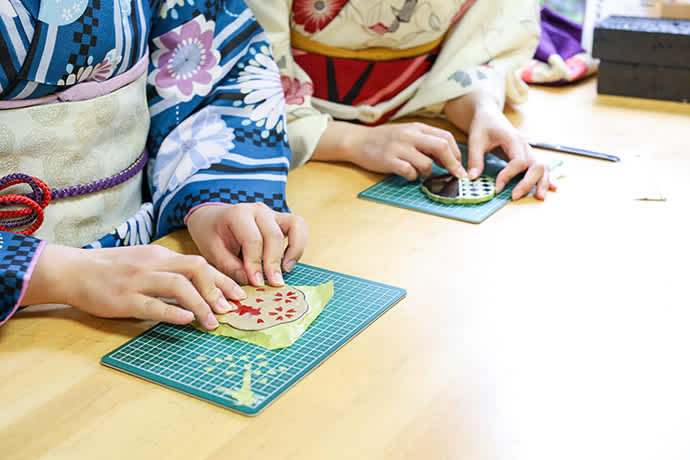
Templates of cherry blossom petals and other designs are available. Photo credit: Gold Leaf Sakuda
Brush adhesive onto the areas where the gold leaf will be applied.
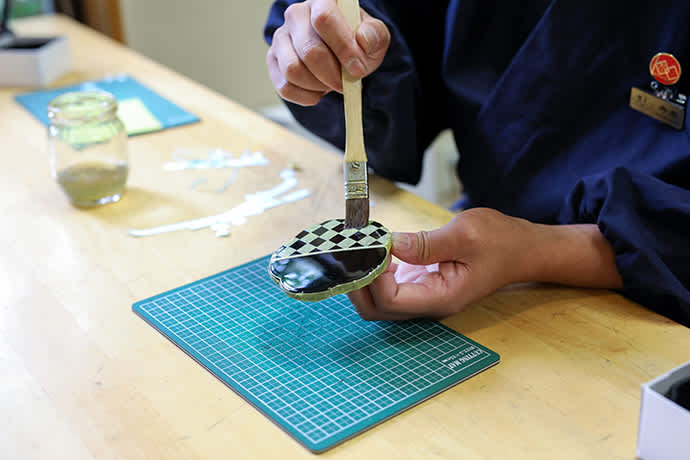
Be careful not to miss any spots. Photo credit: Gold Leaf Sakuda
Apply the gold leaf.
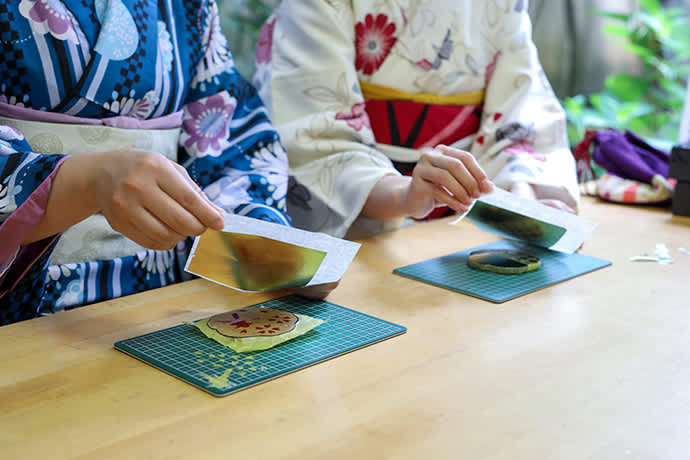
When you touch it, you will be surprised at how thin the gold leaf is. Photo credit: Gold Leaf Sakuda
After applying, brush off the excess gold leaf and fill in any missing areas.
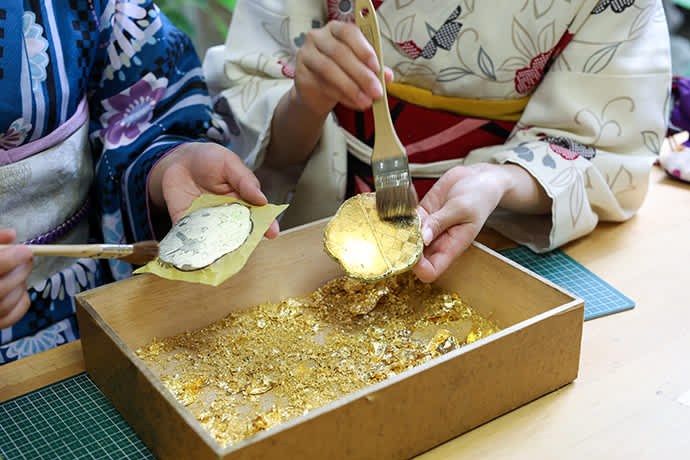
An artisan will advise you on the process and answer any questions. Photo credit: Gold Leaf Sakuda
Once you have finished the gilding work, remove the masking tape and view your work.

You can take your finished item home with you. Photo credit: Gold Leaf Sakuda
The store sells a wide range of products made with gold leaf, from handicrafts to cosmetics and even food, so you can enjoy shopping once the workshop is over. You can also observe the gold leaf production process.

You can participate in gilding workshops at either Gold Leaf Sakuda’s main store (left) or its Machiya store (right). A private workshop can be reserved for a group of 10 or more participants. Both photo credit: Gold Leaf Sakuda
Main photo credit: Hongwanji Kanazawa Betsuin
Information
Jodo Shinshu Hongwanji-ha Kanazawa Betsuin TempleAddress: 2-47 Kasaichimachi, Kanazawa City, Ishikawa Prefecture |
|
WEB:http://www.incl.ne.jp/honganji/ (Japanese) |
Gold Leaf Sakuda |
Kanazawa Yasue Gold Leaf Museum |
|
WEB:https://www.kanazawa-museum.jp/kinpaku/english/index.htm |
Related Links
Ishikawa Travel | THE GOLDEN DESTINATION |




















































